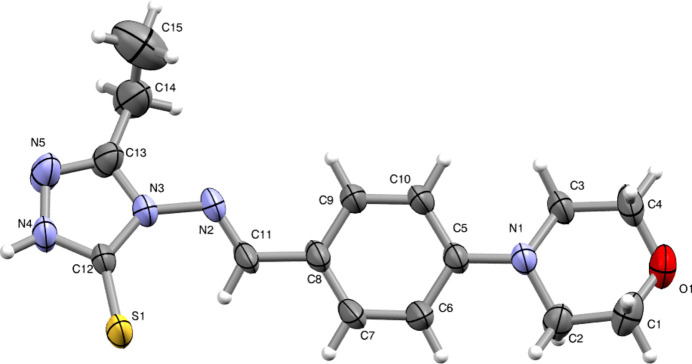X-ray structural insights and computational analysis of the compound 5-ethyl-4-[(4-morpholinobenzylidene)amino]-2,4-dihydro-3H-1,2,4-triazole-3-thione
IF 0.6
Q4 CRYSTALLOGRAPHY
Acta Crystallographica Section E: Crystallographic Communications
Pub Date : 2025-07-01
DOI:10.1107/S2056989025004852
引用次数: 0
Abstract
The molecule of the title compound adopts a non-planar geometry. A significant feature is the puckered six-membered morpholine ring, which adopts a chair conformation. In the crystal, molecules are linked through intermolecular N—H⋯S hydrogen bonds, forming inversion-related dimers with an R22(8) ring motif.
The title compound, C15H19N5OS, crystallizes in the monoclinic crystal system, space group P21/c. The molecule adopts a non-planar geometry. A significant feature of the structure is the puckered six-membered morpholine ring, which adopts a chair conformation. In the crystal, molecules are linked through intermolecular N—H⋯S hydrogen bonds, forming inversion-related dimers with an R22(8) ring motif. A Hirshfeld surface analysis was undertaken to quantify the intermolecular interactions that influence the crystal packing.



化合物5-乙基-4-[(4-茂硝基-苄基)氨基]-2,4-二氢- 3h -1,2,4-三唑-3-硫酮的x射线结构观察和计算分析。
标题化合物C15H19N5OS在单斜晶系P21/c空间群中结晶。分子采用非平面几何结构。该结构的一个显著特征是折叠的六元morpholine环,它采用椅子构象。在晶体中,分子通过分子间N-H⋯S氢键连接,形成具有r22(8)环基序的反转相关二聚体。赫斯菲尔德表面分析进行了定量的分子间相互作用,影响晶体的包装。
本文章由计算机程序翻译,如有差异,请以英文原文为准。
求助全文
约1分钟内获得全文
求助全文
来源期刊

Acta Crystallographica Section E: Crystallographic Communications
Chemistry-Chemistry (all)
CiteScore
1.90
自引率
0.00%
发文量
351
审稿时长
3 weeks
期刊介绍:
Acta Crystallographica Section E: Crystallographic Communications is the IUCr''s open-access structural communications journal. It provides a fast, simple and easily accessible publication mechanism for crystal structure determinations of inorganic, metal-organic and organic compounds. The electronic submission, validation, refereeing and publication facilities of the journal ensure rapid and high-quality publication of fully validated structures. The primary article category is Research Communications; these are peer-reviewed articles describing one or more structure determinations with appropriate discussion of the science.
 求助内容:
求助内容: 应助结果提醒方式:
应助结果提醒方式:


